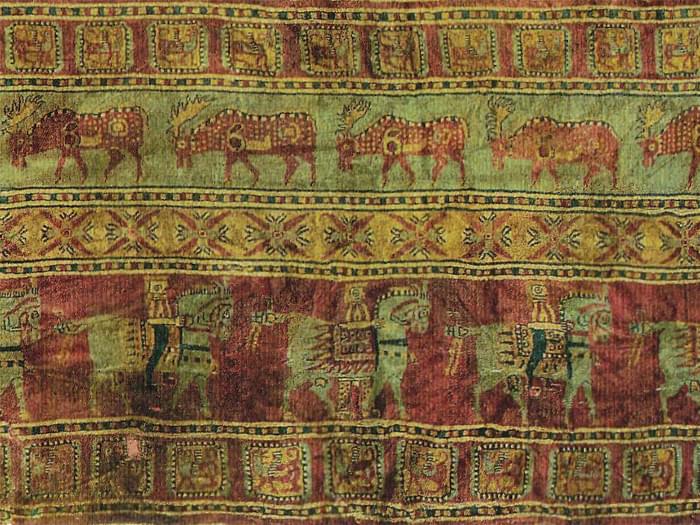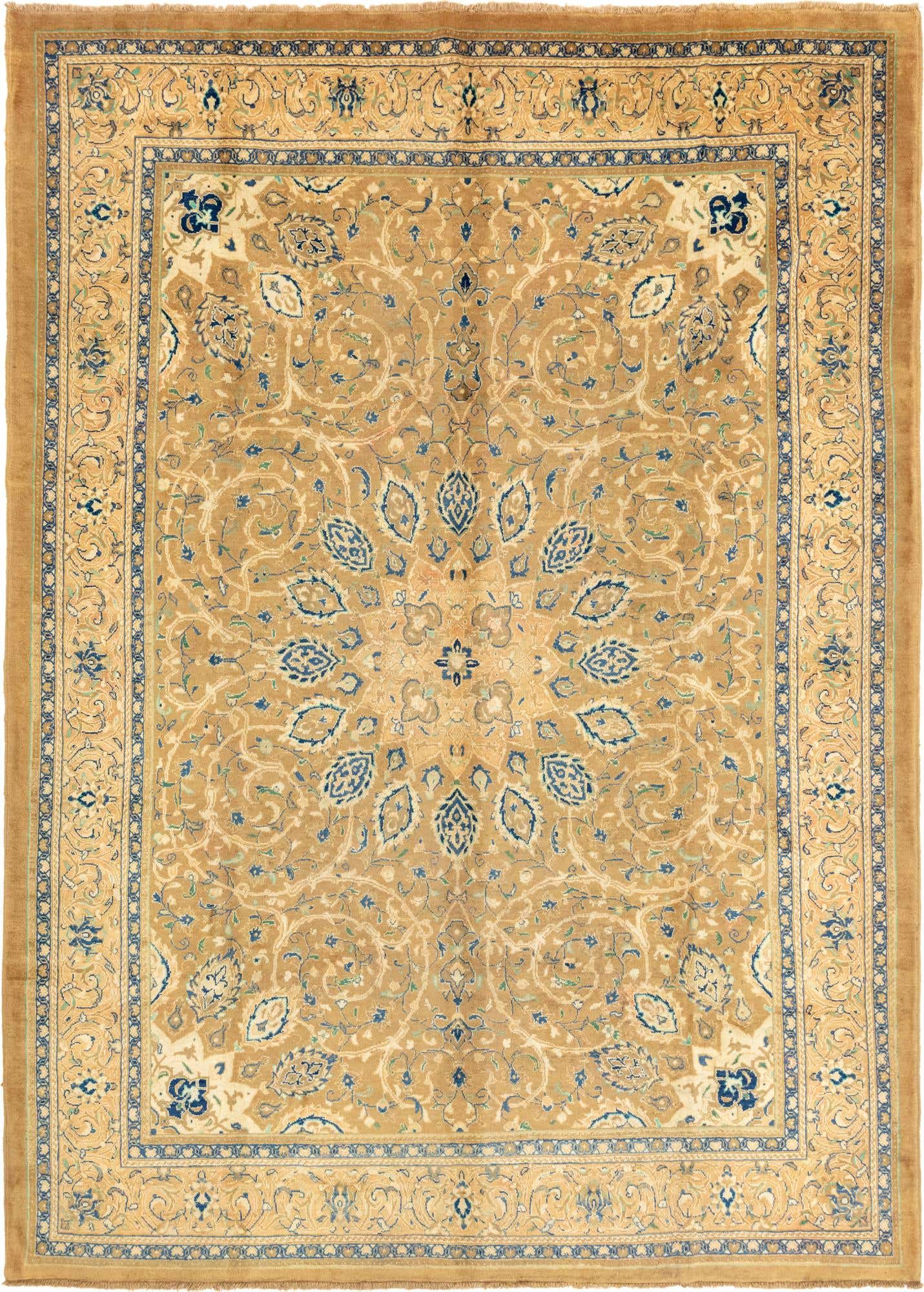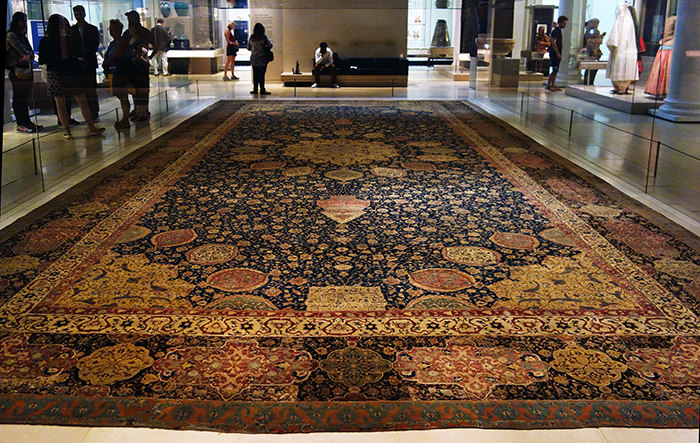Hand-knotted rugs have been an indispensable element of home décor for
centuries, gracing floors with their magnificence all over the globe. But, they are
much more than just mere coverings, as each rug is a testament to the rich
history and culture of the region where it was crafted. With their intricate
designs, vibrant hues, and impeccable craftsmanship, every hand-knotted rug is a
one-of-a-kind masterpiece, possessing a priceless and invaluable quality that is
impossible to replicate.
Hand knotted rugs possess a fascinating and extensive history that spans back
thousands of years. The earliest hand knotted rugs were discovered in ancient
Persia (modern-day Iran) and date back to the 5th century BC. Nomadic tribes,
utilizing wool from their own sheep and goats, were the creators of these
primitive rugs, which were primarily utilized for warmth and insulation. Initially,
these rugs consisted of simplistic geometric shapes. However, over time, rug-
making developed into a more complex and sophisticated art form, with the
Persian rug-makers gaining prominence for their intricate designs and high-quality materials.
By the 16th century, Persian rugs had become highly sought-after luxury items in Europe. As rug-making spread to other parts of the world, various styles and
techniques emerged, influenced by different cultures and traditions. For instance,
Indian rug-making was influenced by Persian designs but had a unique Indian
twist. Silk was frequently utilized in Indian rugs, imparting them with a softer,
more luxurious texture. In contrast, Turkish rug-making was influenced by Persian and Indian designs but possessed its unique Turkish style. Turkish rugs often showcased bold, geometric designs and were made with high-quality wool and silk. Despite the regional differences, hand knotted rugs share many similarities in terms of their use of materials and techniques, showcasing a deep-rooted history that has transcended both time and culture.
The quality and appearance of hand knotted rugs rely heavily on the materials
utilized during their creation. Wool, a durable and versatile material sourced from
sheep, goats, or llamas, is the most commonly used material in hand knotted
rugs. The breed of the animal, climate, and environment in which it was raised all
influence the quality of the wool. Silk, on the other hand, is a more luxurious and
delicate material that gives rugs a shiny and smooth appearance. It is often used
in intricate patterns and borders to add a touch of elegance to the design.
Cotton serves as the foundational material for most hand knotted rugs due to its
ability to provide a sturdy base for the wool or silk knots. This material helps to
maintain the rug’s shape and structure over time, while also being a more cost-
effective option than wool or silk.
In addition to these primary materials, rug makers may incorporate other natural
fibers like jute, hemp, or sisal into their creations. These materials are typically
used for the rug’s backing or as a natural dye base. The process of sourcing and
processing these materials varies depending on the region and cultural traditions.
For example, wool may be spun by hand using a drop spindle in some areas, while modern machinery may be used in others. Silk may be sourced from silkworms raised on mulberry trees or from wild silk. The materials used in hand knotted rugs are a testament to the importance of the craft and the artistry and skill that goes into each piece.
Hand knotting a rug is a labor-intensive process that requires a mastery of various techniques to create a one-of-a-kind piece. To begin, a strong foundation must be established by stretching a warp thread across a loom and tying a weft thread to it. The weft thread is then woven back and forth across the warp thread to form a sturdy base for the rug.
The knotting process involves two primary techniques: the Persian knot and the Turkish knot. The Persian knot, also called the Senneh knot, is tied around two adjacent warp threads. Afterward, the weft thread passes over one warp thread and under the next, locking the knot in place. This technique is common in Persian and Oriental rugs. In contrast, the Turkish knot, also known as the Ghiordes knot, is tied around a single warp thread. The weft thread is then passed over the warp thread and back under itself, firmly securing the knot. This technique is used mainly in Turkish and Caucasian rugs.
After tying the knots, the weft thread is passed over and under the warp threads,
locking the knots in place and creating the pile. The pile’s length and density are determined by the design and intended outcome. Once the pile is complete, the
rug is sheared to create a smooth and uniform surface, using a specialized
shearing knife or scissor.
The final step is washing and finishing the rug, which involves trimming any loose threads and thoroughly inspecting the rug before it is ready for sale. The process requires a high level of skill and artistry, as each rug is unique, with its own design, knotting technique, and materials. The intricate techniques involved in rug making contribute to the beauty and durability of these treasured pieces.
Hand-knotted rugs boast a wide array of styles and designs that reflect the artistic movements and cultural traditions of the region where they were created.
Persian rugs, the most iconic style, boast intricate designs and patterns that
include floral motifs, geometric shapes, and calligraphy. These rugs often
showcase a central medallion surrounded by a repeating patterned field. Oriental
rugs, on the other hand, share similarities with Persian rugs, but are made in
other countries like India, Pakistan, and China. They also feature intricate designs
and patterns, such as floral motifs, geometric shapes, and animal figures. Oriental
rugs typically have a central medallion that is also surrounded by a field of
repeating patterns.
Turkish rugs are recognized for their bold colors and large-scale designs, often
featuring geometric patterns and motifs like stars, diamonds, and hexagons. They
also frequently showcase a central medallion, surrounded by a field of repeating
patterns. Meanwhile, Caucasian rugs, created in the Eastern European Caucasus
region, are famous for their bold colors and geometric designs that incorporate
intricate motifs like stars, crosses, and animals. These rugs also typically have a
central medallion that is surrounded by a field of repeating patterns.
Kilim rugs, unlike other styles, are crafted using a flat weaving technique instead
of knotting. They are usually produced in Turkey, Iran, and Afghanistan, and are
known for their bold colors and geometric patterns. These rugs are often used as
wall hangings or decorative throws. Every style and design of hand-knotted rug
holds a unique history and cultural significance. Rug makers often draw on
traditional designs and techniques, but also incorporate modern elements to
create new and innovative designs.
Hand knotted rugs are highly prized for their beauty, intricate craftsmanship, and
durability. However, not all hand knotted rugs are created equal, and the factors
that affect their value and price can vary significantly. Here are the crucial factors
that determine the worth of a hand-knotted rug:
Material – The type of material used to weave the rug is a crucial factor that
determines its value and price. Silk rugs, for example, are more expensive and
prized than wool rugs because of their luxurious softness, lustrous sheen, and fine details. However, wool rugs are also valued for their natural beauty and
durability.
Knot Count – The knot count refers to the number of knots per square inch in the
rug. A higher knot count means a more intricate and detailed design, resulting in a more valuable rug. For instance, rugs with a knot count of 500 or more are
considered to be of high quality.
Design and Pattern – The design and pattern of the rug also affect its value and
price. Intricately designed and patterned rugs, such as Persian rugs, tend to be
more valuable and expensive than those with simpler designs.
Age – The age of a rug is also a critical factor in determining its value and price.
Antique rugs, which are typically over 100 years old, are prized for their rarity and historical significance, and can command high prices.
Condition – The condition of the rug is another crucial factor in its value and price.
Rugs that are well-maintained and free from damage, stains, or discoloration are
more valuable than those that are worn or damaged.
Size – The size of the rug is another element that influences its value and price.
Larger rugs tend to be more expensive than smaller ones, due to the amount of
material and time required to create them.
Rarity – Finally, the rarity of a rug can greatly affect its value and price. One-of-a-
kind rugs or those made by highly skilled and renowned artists can command
premium prices due to their uniqueness and scarcity.
In summary, the value and price of hand knotted rugs depend on various factors,
including the type of material, knot count, design, age, condition, size, and rarity.
Understanding these factors can help you make an informed decision when
buying or selling a hand-knotted rug.
Hand knotted rugs are a truly valuable investment, and it’s crucial to take good care of them to ensure their longevity and beauty. To keep your rug clean and
free of dirt and dust, regular vacuuming is essential. In high-traffic areas, it’s recommended to vacuum your rug at least once a week. To prevent uneven wear
and tear, it’s important to rotate your rug every 6 months or so. This will help distribute the foot traffic evenly and prevent excessive wear in one area.
In the event of a stain, it’s crucial to clean it up as soon as possible to prevent it from setting. Use a clean cloth and a mild detergent to gently blot the stain, and
avoid rubbing or scrubbing the rug, as this can damage the fibers. Keep in mind
that direct sunlight can fade and damage your hand knotted rug over time, so it’s important to place your rug away from windows or use curtains or blinds to block
out the sunlight.
For a deeper clean, it’s recommended to have your hand knotted rug
professionally cleaned every 2-3 years. Professional cleaners use specialized
equipment and cleaning solutions to remove dirt, dust, and stains without
damaging the fibers. Additionally, rug pads can help protect your hand knotted
rug from wear and tear, and prevent it from slipping or sliding on hard floors.
Make sure to choose a high-quality rug pad that is appropriate for your flooring
type and the size of your rug.
By following these tips, you can enjoy the beauty and value of your hand knotted
rug for years to come. With proper care, your rug will continue to enhance the
beauty of your home and provide warmth and comfort to you and your family.
Properly storing hand knotted rugs is crucial for preserving their quality and
durability over an extended period of time. Here are some helpful tips to ensure
your rug remains in pristine condition:
Achieving a Clean Start – Before you store your rug, ensure it’s thoroughly cleaned to remove dirt, dust, and stains. Gently vacuum your rug, spot clean any stains with a mild detergent and a clean cloth, then allow it to dry entirely before proceeding.
Rolling it Up – Roll your rug tightly, making sure to roll it with the pile facing
inwards to prevent any fiber damage. Avoid folding the rug, as this can result in
permanent creases.
Acid-Free Paper Wrap – To protect your rug from moisture and pests, wrap it
carefully in acid-free paper before storing it. Refrain from using plastic bags or
coverings as they tend to trap moisture, causing mold or mildew to form.
Optimal Storage Conditions – Store your rug in a dry, cool place, far from any
direct sunlight or heat sources. It’s important to avoid storing it in damp areas such as basements or attics, as this can cause harm to the fibers.
Periodic Check-Ups – Regularly inspect your rug while it’s in storage to ensure it’s in good condition. If you notice any signs of mold, mildew, or insect damage, take
action right away to prevent further damage.
By following these suggestions, you’ll safeguard your hand knotted rug and
maintain its beauty and worth for years to come. When you’re ready to use your rug again, carefully unroll it and let it rest for a few days before placing any
furniture or walking on it. With proper care, your hand knotted rug will continue
to delight and enrich your home.
Hand knotted rugs are prized for their durability and longevity. However, over
time, they may become damaged or worn due to frequent use or exposure to
environmental elements. If you notice any damage to your rug, it’s important to take immediate action to prevent it from getting worse.
Before attempting any repairs, it’s important to assess the extent of the damage. Minor damage such as loose threads or small holes can often be repaired easily at home. However, more extensive damage such as large holes or tears may require the services of a professional repair service.
Once you’ve assessed the damage, gather the necessary supplies for the repair. For minor repairs, a sharp pair of scissors, a needle, and matching thread will
suffice. For larger repairs, you may need to purchase replacement yarn or seek
the assistance of a professional repair service.
For loose threads, resist the urge to pull them, as this can cause further damage
to the rug. Instead, carefully trim the loose threads with scissors and secure the
surrounding threads with a small amount of fabric glue or clear nail polish.
For small holes, use a needle and matching thread to sew the hole closed. Knot
the thread securely on the underside of the rug to prevent it from coming loose. If
a section of your rug is missing yarn, you can purchase matching yarn and
carefully weave it into the damaged area. This can be a time-consuming process,
so it may be best to hire a professional for extensive repairs.
In case of extensive damage or if you are unsure how to repair the damage yourself, it’s recommended to seek the services of a professional repair service.
They can assess the damage and provide an estimate for the repair.
By following these tips and taking good care of your hand knotted rug, you can
extend its lifespan and enjoy its beauty for many years to come.
Hand-knotted rugs are not only beautiful but also valuable pieces of home decor
that require regular cleaning to maintain their appearance and longevity.
Vacuum Regularly – To keep your rug clean, it is crucial to vacuum it regularly. Use a vacuum cleaner with a beater bar or rotating brush to remove dirt and dust
from the rug’s surface. Don’t forget to vacuum both sides of the rug to remove all debris and ensure it stays in top condition.
Spot Clean Stains – If you notice a stain on your rug, it is essential to spot clean it
immediately. Using a clean cloth and a mixture of warm water and mild
detergent, gently blot the stain. Rubbing the stain is not recommended as it can
cause it to spread.
Deep Clean – For a deeper clean, you can either hand wash your rug or have it
professionally cleaned. If you choose to hand wash your rug, use a mild detergent
and a soft-bristled brush to avoid damage. Thoroughly rinse the rug with clean
water and allow it to air dry. This method helps to maintain the rug’s quality and condition.
Professional Cleaning – For those who prefer professional cleaning services, look
for a reputable rug cleaning service in your area. They will have the equipment
and expertise to deep clean your rug without causing damage. This approach
helps to maintain the rug’s quality and keep it looking brand new.
Rotate the Rug – To prevent uneven wear and tear, rotate your rug regularly. This
will distribute foot traffic and sun exposure evenly across the rug, maintaining its
appearance for years to come.
Protect from Sunlight – Hand-knotted rugs are susceptible to sun damage.
Therefore, it is crucial to protect them from direct sunlight. Using window
coverings or UV-resistant film on your windows can help prevent fading and
discoloration.
By following these tips, you can keep your hand-knotted rug clean and in
excellent condition for years to come. Regular vacuuming, spot cleaning, deep
cleaning, and proper protection from sunlight can help extend the lifespan of your rug and keep it looking beautiful.

























